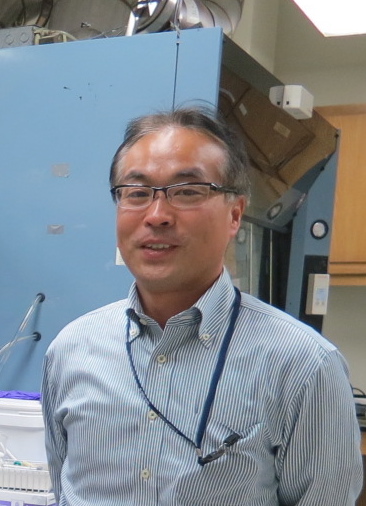Org. Synth. 2015, 92, 171-181
DOI: 10.15227/orgsyn.092.0171
Synthesis of 2-Azido-1,3-dimethylimidazolinium Hexafluorophosphate (ADMP).
Submitted by Mitsuru Kitamura
*1 and Kento Murakami
Checked by Raul Leal and Richmond Sarpong
1. Procedure
CAUTION: Although 2-azido-1,3-dimethylimidazolinium hexafluorophosphate (ADMP) was found to be safe and stable in the safety tests (impact sensitivity test, friction sensitivity test, DSC), it is potentially explosive. It must be handled with care. This preparation should be carried out in a well-ventilated hood and should be conducted behind a safety shield.
A.
2-Chloro-1,3-dimethylimidazolinium Hexafluorophosphate (2). An oven-dried 250-mL round-bottomed flask equipped with a 3-cm Teflon-coated magnetic stirbar and a rubber septum (containing nitrogen inlet and outlet needles) is charged with
2-chloro-1,3-dimethylimidazolinium chloride (
1) (
Note 1) (21.2 g, 125 mmol, 1.0 equiv) and
potassium hexafluorophosphate (Notes
2 and
3) (23.1 g, 126 mmol, 1.0 equiv) by temporary removal of the septum, and 60 mL of
acetonitrile (
Note 4) is added by syringe through the septum. The mixture is stirred for 10 min at room temperature then vacuum filtered through a pad of dry Celite (2 g) packed in a 60 mL sintered glass filter funnel (
Note 5). The filter cake is washed with
acetonitrile (3 x 20 mL), then the filtrate is concentrated on a rotary evaporator (heating bath temp < 50 °C, 15 mmHg). The residue is dissolved in a small amount of
acetonitrile (15 mL) and the solution is poured into a 300 mL Erlenmeyer flask with
diethyl ether (100 mL), under stirring, over the course of 2-3 min, to form an off-white precipitate. The suspension is vacuum-filtered through a 150 mL Büchner funnel with medium porosity filter paper. The solids are washed with
diethyl ether (3 x 10 mL), then collected and dried under vacuum (22 °C, 0.2 mmHg) for 12 h to afford
2-chloro-1,3-dimethylimidazolinium hexafluorophosphate (
2) (
Note 6) (31.9-32.2 g, 91%).
B.
2-Azido-1,3-dimethylimidazolinium Hexafluorophosphate (ADMP, 3). An oven-dried 250-mL round-bottomed flask equipped with a 3-cm Teflon-coated magnetic stirbar and a rubber septum (containing nitrogen inlet and outlet needles) is charged with
2-chloro-1,3-dimethylimidazolinium hexafluorophosphate (
2) (31.4 g, 113 mmol, 1.0 equiv) and
sodium azide (
Note 7) (11.0 g, 169 mmol, 1.5 equiv) by temporary removal of the septum. The flask is placed in a room temperature water bath and 115 mL of
acetonitrile is added by syringe through the septum (
Note 8). The mixture is stirred for 1 h at room temperature, then filtered through a pad of dry Celite (2 g) packed in a 60 mL sintered glass filter funnel (
Note 5). The filter cake (
Note 9) is washed with
acetonitrile (3 x 30 mL), and the filtrate is concentrated on a rotary evaporator (heating bath temp < 50 °C). The residue is dissolved in a small amount of
acetonitrile (13 mL) and the solution is poured into a 300 mL Erlenmeyer flask with
diethyl ether (100 mL), under stirring, over the course of 2-3 min, to form a white precipitate. The suspension is vacuum-filtered through a 150 mL Büchner funnel with medium porosity filter paper. The solids are washed with
diethyl ether (3 x 10 mL) then collected and dried under vacuum (22 ºC, 0.2 mmHg) for 12 h to afford
2-azide-1,3-dimethylimidazolinium hexafluorophosphate (
3) (30.1-30.5 g, 94-95%) Further purification of the title compound
3 is achieved by recrystallization (
Note 10) from
toluene and
acetone to afford pure
2-azido-1,3-dimethylimidazolinium hexafluorophosphate (
3) as white crystals (26.8-27.5 g, 83-85%) (
Note 11).
2. Notes
1. Both submitters and checkers purchased
2-chloro-1,3-dimethylimidazolinium chloride (> 80.0 %) from Tokyo Chemical Industry (TCI) and used it as received. This material is very hygroscopic. Material was used each time from a new bottle, and weighed quickly under air.
2. The submitters and the checkers purchased
potassium hexafluorophosphate (>97%) from Wako Pure Chemical Industries, and used it as received.
3. Kiso
et al. reported the synthesis of
2-chloro-1,3-dimethylimidazolinium hexafluorophosphate by the reaction of
2-chloro-1,3-dimethylimidazolinium chloride and ammonium hexafluorophosphate, see: Akaji, K.;Kuriyama, N.; Kimura, T.; Fujiwara, Y.; Kiso, Y.
Tetrahedron Lett. 1992, 33, 3177; Kiso, Y.; Fujiwara, Y.; Kimura, T.; Nishitani A.; Akaji, K.
Int. J. Peptide Protein Res. 1992,
40, 308. The submitters chose to use
potassium hexafluorophosphate for the anion exchange, because it is a cheaper alternative compared to ammonium hexafluorophosphate.
4.
Acetonitrile (99.8%) was purchased from Sigma-Aldrich in a Sure/Seal bottle and was used as received.
5. Celite 545 was purchased from Wako Pure Chemical Industries. The Celite was packed tightly into the funnel using the bottom of a beaker.
6. The isolated
2-chloro-1,3-dimethylimidazolinium hexafluorophosphate (
2) has the following physicochemical properties: mp 231-232 °C (decomp.); IR (ATR, uncorrected) cm
-1: 1637, 1548, 1299, 819, 620, 554;
1H NMR
pdf(600 MHz, CD
3CN) δ: 3.11 (s, 6 H), 3.93 (s, 4 H);
13C NMR
pdf(151 MHz, CD
3CN) δ: 35.2, 50.8, 157.1;
19F NMR
pdf(376 MHz, CD
3CN) δ: -71.71 (d,
J = 706.6 Hz); Anal. calcd for C
5H
10ClF
6N
2P: C, 21.56; H, 3.62; N, 10.06. Found: C, 21.24; H, 3.49; N, 9.90; HRMS (
m/z) calcd for [C
5H
10N
2Cl]
+: 133.0527. Found: 133.0526.
7.
Sodium azide (>98%) was purchased from Wako Pure Chemical Industries and was used as received for both submitters and checkers.
8. The submitters reported running the reaction at 0 ºC for 30 min. The reaction was found to be sluggish at 0 ºC, but went to completion at 22 ºC within 1 h. The internal temperature of the reaction was monitored with a thermometer, and no change (>2 ºC) in internal temperature was noted during addition of
acetonitrile and over the course of the reaction.
9. The filter cake contains excess
sodium azide used in the reaction. The cake was diluted with water and disposed as waste liquid, keeping the waste separate from other waste streams that contain metals, oxidizing reagents, and chlorinated solvents.
10. While the obtained material is of sufficient purity for efficient diazo-transfer reactions, the
2-azido-1,3-dimethylimidazolinium hexafluoro-phosphate (
ADMP,
3) was recrystallized by dissolving the crude product in the minimum amount of 1:1 toluene:acetone necessary (160 mL) at 50 ºC (heated using a water bath). The material was allowed to cool to room temperature, and then placed in a -20 ºC freezer overnight. The crystals were collected by vacuum filtration through a Büchner funnel with medium porosity filter paper, and were washed with cold (-20 ºC) 1:1 toluene:acetone (2 x 10 mL). The solids were collected and dried under vacuum (22 ºC, 0.2 mmHg) for 12 h. The filtrate was concentrated on a rotary evaporator. This concentrated residue was recrystallized twice more using the same method using 70 mL and 15 mL of 1:1 toluene:acetone, respectively. The white crystals were combined and analyzed for the properties listed in Note 11.
11. The 2-azido-1,3-dimethylimidazolinium hexafluorophosphate (
ADMP,
3) has the following physicochemical properties: mp 202-204 °C (decomp); IR (ATR, uncorrected) cm
-1: 2172, 1638, 1579, 1307, 1289, 819, 668, 554;
1H NMR
pdf(600 MHz, CD
3CN) δ: 3.05 (s, 6 H), 3.79 (s, 4 H);
13C NMR
pdf(151 MHz, CD
3CN) δ: 33.8, 50.0, 156.5;
19F NMR
pdf(376 MHz, CD
3CN) δ: -71.81 (d,
J = 706.6 Hz); Anal. calcd for C
5H
10F
6N
5P: C, 21.06; H, 3.54; N, 24.56. Found: C, 21.08; H, 3.63; N, 24.39; HRMS (
m/z) calcd for [C
5H
10N
5]
+: 140.0931. Found: 140.0929.
Working with Hazardous Chemicals
The procedures in
Organic Syntheses are intended for use only by persons with proper training in experimental organic chemistry. All hazardous materials should be handled using the standard procedures for work with chemicals described in references such as "Prudent Practices in the Laboratory" (The National Academies Press, Washington, D.C., 2011; the full text can be accessed free of charge at
http://www.nap.edu/catalog.php?record_id=12654). All chemical waste should be disposed of in accordance with local regulations. For general guidelines for the management of chemical waste, see Chapter 8 of Prudent Practices.
In some articles in Organic Syntheses, chemical-specific hazards are highlighted in red "Caution Notes" within a procedure. It is important to recognize that the absence of a caution note does not imply that no significant hazards are associated with the chemicals involved in that procedure. Prior to performing a reaction, a thorough risk assessment should be carried out that includes a review of the potential hazards associated with each chemical and experimental operation on the scale that is planned for the procedure. Guidelines for carrying out a risk assessment and for analyzing the hazards associated with chemicals can be found in Chapter 4 of Prudent Practices.
The procedures described in Organic Syntheses are provided as published and are conducted at one's own risk. Organic Syntheses, Inc., its Editors, and its Board of Directors do not warrant or guarantee the safety of individuals using these procedures and hereby disclaim any liability for any injuries or damages claimed to have resulted from or related in any way to the procedures herein.
3. Discussion
Organic azides are generally synthesized by the nucleophilic substitution of a leaving group on an organic compound with an azide ion.
2 The diazo-transfer reaction of primary amines is an alternative method for synthesizing organic azides. Trifluoromethanesulfonyl azide (TfN
3) has been used as a diazo-transfer reagent for primary amines,
3 and the diazo-transfer reaction proceeds efficiently with the help of a metal catalyst such as Cu
II salt.
3c,3d,3e,3f,3g However, the reaction has several drawbacks. The safety and stability of the diazo-transfer reagent is a concern; TfN
3 has an explosive nature and requires very careful treatment.
3b,4 Furthermore, it has poor reactivity toward poorly nucleophilic primary amines such as anilines with electron-withdrawing groups.
3e Several low-explosive reagents have recently been reported for diazo-transfer to primary amines, such as nonafluorobutanesulfonyl azide,
5 imidazole-1-sulfonyl azide,
6 benzotriazol-1-yl-sulfonyl azide.
72-Azido-1,3-dimethylimidazolinium hexafluorophosphate (
ADMP) is safe and stable crystalline solid, and show efficient diazo-transfer ability to primary amines.
8 ADMP is not very hygroscopic and can be stored in a freezer (at -10 °C) for at least two months. Impact sensitivity tests
9 and friction sensitivity tests
10 showed that
ADMP is not explosive in the test ranges. The exothermic decomposition of
ADMP was observed through differential scanning calorimetry experiments from approximately 200 °C.
8a These results suggest that
ADMP can be safely used below its decomposition temperature, preferably below 100 °C in order to allow an appropriate safety margin.
The diazo-transfer reaction of
ADMP to primary amines proceeded smoothly in the presence of 4-(
N,
N-dimethyl)aminopyridine (DMAP) as a base and the reaction did not require the addition of metal catalyst (Scheme 1).
11 Even though low nucleophilic anilines substituted with strong electron-withdrawing groups such as acetyl, cyano and nitro groups were employed, the diazo-transfer reaction proceeded at 50 °C.
Compared to low nucleophilic amines, the diazo-transfer reaction to nucleophilic amines proceeded easier at low temperature (30 °C). However, for the diazo-transfer to less-hindered primary alkyl amines, DMAP was not suitable as a base, but a stronger base such as alkylamine or DBU was appropriate.
In addition to diazo-transfer to primary amines,
ADMP and its corresponding chloride (ADMC), which was prepared by the reaction of
2-chloro-1,3-dimethylimidazolinium chloride (
DMC) and
sodium azide, could be used for various nitrogen functionalization (Scheme 2).
12ADMP and ADMC reacted with 1,3-dicarbonyl compounds under mild basic conditions to give 2-diazo-1,3-dicarbonyl compounds in high yields, which are easily isolated because the by-products are highly soluble in water.
13 Naphthols also reacted with ADMC to give corresponding diazonaphthoquinones in good to high yields.
14 In addition, 2-azido-1,3-dimethylimidazolinium salts were found to be employed as azide-transfer
15 and migratory amination reagents.
16
Appendix
Chemical Abstracts Nomenclature (Registry Number)
2-Chloro-1,3-dimethylimidazolinium chloride: 1H-Imidazolium, 2-chloro-4,5-dihydro-1,3-dimethyl-, chloride (1:1); (1) (37091-73-9)
Potassium hexafluorophosphate: Phosphate(1-), hexafluoro-, potassium (1:1); (17084-13-8)
2-Chloro-1,3-dimethylimidazolinium hexafluorophosphate: 1H-Imidazolium, 2-chloro-4,5-dihydro-1,3-dimethyl-, hexafluorophosphate(1-) (1:1); (2) (101385-69-7)
Sodium azide: Sodium azide (Na(N3)); (26628-22-8)
2-Azido-1,3-dimethylimidazolinium hexafluorophosphate: 1H-Imidazolium, 2-azido-4,5-dihydro-1,3-dimethyl-, hexafluorophosphate(1-) (1:1); (3) (1266134-54-6)

|
Mitsuru Kitamura was born in Takamatsu, Japan, in 1971 and received his B.Sc. in 1994 and M. Sc. in 1996 from Keio University. He received his Ph.D. in 1999 from Tokyo Institute of Technology under the direction of Professor K. Suzuki. Then, he was appointed as research associate in Professor K. Narasaka's group at the University of Tokyo. In 2005, he moved to Kyushu Institute of Technology as associate professor, and promoted to full professor in 2015. He was a recipient of the Chemical Society of Japan Award for Young Chemists (2005) and Award for a Creative Young Chemist, Kyushu-Yamaguchi Branch, the Society of Synthetic Organic Chemistry, Japan (2011). |

|
Kento Murakami was born in Matsuyama, Japan, in 1990. He received his B. Eng. in 2013 from Kyushu Institute of Technology. In the same year, he began his graduate studies at the same institute under the guidance of Professor Mitsuru Kitamura. |

|
Raul Leal was born in Chesapeake, Virginia in 1988. He received his Bachelor of Science in 2010 from the State University of New York at Binghamton. He is currently pursuing graduate studies in the area of natural product synthesis under the mentorship of Professor Richmond Sarpong at the University of California, Berkeley. |
Copyright © 1921-, Organic Syntheses, Inc. All Rights Reserved